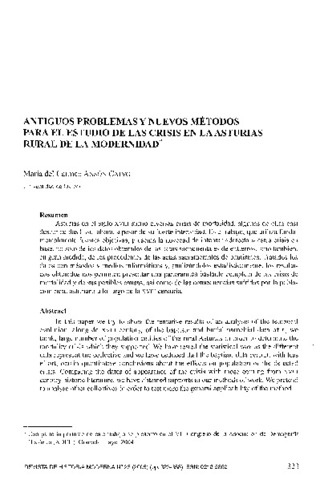Antiguos problemas y nuevos métodos para el estudio de la crisis en la Asturias rural de la modernidad
Autor(es) y otros:
Fecha de publicación:
Editorial:
Universidad de Alicante. Departamento de Historia Medieval, Historia Moderna y Ciencias y Técnicas Historiográficas
Versión del editor:
Citación:
Descripción física:
Resumen:
Asturias en el siglo XVIII sufrió diversas crisis de mortalidad, algunas de ellas casi desconocidas hasta ahora, a pesar de su fuerte intensidad. Este trabajo, que utiliza fundamentalmente fuentes objetivas, presenta la novedad de intentar «detectar» estas crisis en base, no sólo de los datos obtenidos de las actas sacramentales de entierros, sino también, en gran medida, de los procedentes de las actas sacramentales de bautismos. Tratados los datos con métodos y medios informáticos y, analizándolos estadísticamente, los resultados obtenidos nos permiten presentar una panorámica bastante completa de las crisis de mortalidad y de sus posibles causas, así como de las consecuencias sufridas por la población rural asturiana a lo largo de la XVIII centuria.
Asturias en el siglo XVIII sufrió diversas crisis de mortalidad, algunas de ellas casi desconocidas hasta ahora, a pesar de su fuerte intensidad. Este trabajo, que utiliza fundamentalmente fuentes objetivas, presenta la novedad de intentar «detectar» estas crisis en base, no sólo de los datos obtenidos de las actas sacramentales de entierros, sino también, en gran medida, de los procedentes de las actas sacramentales de bautismos. Tratados los datos con métodos y medios informáticos y, analizándolos estadísticamente, los resultados obtenidos nos permiten presentar una panorámica bastante completa de las crisis de mortalidad y de sus posibles causas, así como de las consecuencias sufridas por la población rural asturiana a lo largo de la XVIII centuria.
In this paper we try to show the tentative results of an analysis of the temporal evolution, along of XVIII century, of the baptism and burial parochial data of a, we think, large number of population entities of the rural Asturias in order to determine the mortality crisis which they supported. We have tested the statistical way as the different data represent the collective and we have deduced that the baptism data permit, with less effort, obtain quantitative conclusions about the effects on population of the detected crisis. Comparing the dates of appearance of the crisis with those coming from XVIII century historic literature, we have obtained supports to our methods of work. We pretend to analyse other collectives in order to test more the general applicability of the method.
In this paper we try to show the tentative results of an analysis of the temporal evolution, along of XVIII century, of the baptism and burial parochial data of a, we think, large number of population entities of the rural Asturias in order to determine the mortality crisis which they supported. We have tested the statistical way as the different data represent the collective and we have deduced that the baptism data permit, with less effort, obtain quantitative conclusions about the effects on population of the detected crisis. Comparing the dates of appearance of the crisis with those coming from XVIII century historic literature, we have obtained supports to our methods of work. We pretend to analyse other collectives in order to test more the general applicability of the method.
Ficheros en el ítem





